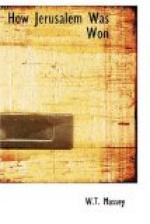The Yeomanry Mounted Division had made a grand fight against a vastly superior force of the enemy in a country absolutely unfavourable to the movement of mounted troops. They never had more than 1200 rifles holding a far-flung barren and bleak line, and the fine qualities of vigorous and swift attack, unfaltering discipline and heroic stubbornness in defence under all conditions, get their proof in the 499 casualties incurred by the Division in the hill fighting, exclusive of those sustained by the 7th Mounted Brigade which reinforced them. The Division was made up entirely of first-line yeomanry regiments whose members had become efficient soldiers in their spare time, when politicians were prattling about peace and deluding parties into the belief that there was little necessity to prepare for war. Their patriotism and example gave a tone to the drafts sent out to replace casualties and the wastage of war, and were a credit to the stock from which they sprang.
While the Yeomanry Mounted Division had been fighting a great battle alongside the infantry of the XXIst Corps in the hills, the remainder of the troops of the Desert Mounted Corps were employed on the plain and in the coastal sector, hammering the enemy hard and establishing a line from the mouth of the river Auja through some rising ground across the plain. They were busily engaged clearing the enemy out of some of the well-ordered villages east of the sandy belt, several of them German colonies showing signs of prosperity and more regard for cleanliness and sanitation than other of the small centres of population hereabouts. The village of Sarona, north of Jaffa, an almost exclusively German settlement, was better arranged than any others, but Wilhelma was a good second.
The most important move was on November 24, when, with a view to making the enemy believe an attack was intended against his right flank, the New Zealand Mounted Rifles Brigade was sent across the river Auja to seize the villages of Sheikh Muannis near the sea, and Hadrah farther inland, two companies of infantry holding each of the two crossings. The enemy became alarmed and attacked the cavalry in force early next morning, 1000 infantry marching on Muannis. The Hadrah force was driven back across the Auja and the two companies of infantry covering the crossing suffered heavily, having no support from artillery, which had been sent into bivouac. Some of the men had to swim the river. A bridge of boats had been built at Jerisheh mill during the night, and by this means men crossed until Muannis was occupied by the enemy later in the morning. The cavalry crossed the ford at the mouth of the Auja at the gallop. The 1/4th Essex held on to Hadrah until five out of six officers and about fifty per cent. of the men became casualties. There was a good deal of minor fighting on this section of the front, and in a number of patrol encounters the resource of the Australian Light Horse added to their bag of prisoners and to the Army’s store of information. Nothing further of importance occurred in this neighbourhood until we seized the crossings of the Auja and the high ground north of the river a week before the end of the year.




